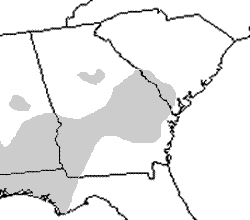Bird-voiced Treefrog (Hyla avivoca)



Photos by J.D. Willson unless otherwise noted
Bird-voiced Treefrog’s Call
Description: The bird-voiced treefrog is usually a mottled gray, but like many treefrogs, its dorsal coloration may change to brownish or green with temperature or activity. This frog is easily mistaken for the larger gray treefrog, which is very similar in coloration, including a light square below the eye. The bird-voiced treefrog is most easily distinguished from its look-alike by the greenish yellow flash colors on the concealed portion of its hind leg, which are usually more orange in color in the gray treefrog. Bird-voiced treefrogs inhabit wooded swamplands of the South, where they can be heard calling during spring and summer.
Range and Habitat: Bird-voiced treefrogs are found in parts of Louisiana, western parts of Tennessee, southern central Alabama, most of the Florida panhandle, parts of central and southern Georgia, and just over the border of South Carolina. These frogs can be found in large stream and river systems that are near cypress-tupelo gum swamps. Sites, where bird-voiced treefrogs breed, normally contain a large amount of brush. When not looking for mates, these frogs are found high up in bald cypress, tupelo gum, and other trees. Sometimes they can be found in dense vegetation at lower levels.
Habits: This species isn’t well studied. It is active primarily in the evening during late spring and summer. Once it reaches over 70* F, males will begin to call for mates during the day. It is assumed that bird-voiced treefrogs spend their entire lives in cypress-tupelo gum river swamp habitats. Amplexus occurs near the bushes along the waterline with the female carrying the male to the water. She will then lay between 400-800 eggs in small clusters. The eggs sink to the bottom and stick to the bottom. They hatch in two days. Tadpoles will metamorphosize within one month.
Call: The call sounds like a very birdlike with a series of rapid repeated, high-pitched, whistle like notes. Some consider that the cadence and syncopation sounds similar to pileated woodpecker.
Conservation Status: Just as many species of frogs, bird-voiced treefrogs are suspectable to a range of environmental factors from urbanization. Their actual status in the Southeast isn’t well defined in the area though due to them not being well studied.
Pertinent References:
Conant, Roger, and Joseph T. Collins. A Field Guide to Reptiles & Amphibians: Eastern and Central North America. 3rd ed. Boston: Houghton Mifflin, 1998.
Dorcas, Mike, and Whit Gibbons. Frogs and Toads of the Southeast. Athens: University of Georgia, 2008.
Jensen, John B., Carlos D. Camp, Whit Gibbons, and Matt J. Elliott. Amphibians and Reptiles of Georgia. Athens: University of Georgia, 2008.
Account Author: Lindsay Partymiller; Katrina M. Ford
